
The Minister of Culture, Lina Mendoni, inaugurated the fully renovated Archaeological Museum of Thira, offering the local community and the thousands of visitors to Santorini a new cultural gem with modern museum standards. This event also marks the beginning of the tourist season on the island, highlighting the dynamic promotion of the region’s cultural heritage.
The Minister of Culture emphasized in her address:
“Today is an important day for Santorini, for the Cyclades, and for the Ministry of Culture. Today, the Ministry of Culture delivers its 27th museum, from 2019 until now. Twenty-seven museums, either newly established or fully renovated and modernized. Twenty-seven museums in six years is already a record, and for this we must thank and congratulate the services of the Ministry of Culture. The museums we create and deliver to local communities serve both as cultural hubs and as resources for development. Of course, they could not have been established without the financial tools and the utilization and exploitation of every available euro. Today, the Archaeological Museum of Thira opens its doors, a project included in the Cultural Charter for Development and Prosperity, which we have designed at the Ministry of Culture for each region of our country.
Our first visit to Santorini, after the initial months of the pandemic, was with Prime Minister Kyriakos Mitsotakis, in 2020. At that time, we promised that the wall paintings of Akrotiri—one of the most important collections of Thira’s archaeological treasures, which had been kept in storage and remained unknown and inaccessible to the general public for a long time—would be exhibited at the Museum of Prehistoric Thira the following year. One year later, the exhibition ‘Theran Wall Paintings: The Treasure of the Prehistoric Aegean’ was inaugurated, making the wall paintings accessible and open to visitors for the first time. Then, in 2021, we made a new promise: that the Archaeological Museum of Thira would be fully renovated according to modern museum standards. Our goal was for Santorini to become a central destination in the Mediterranean, also in the field of cultural tourism.”
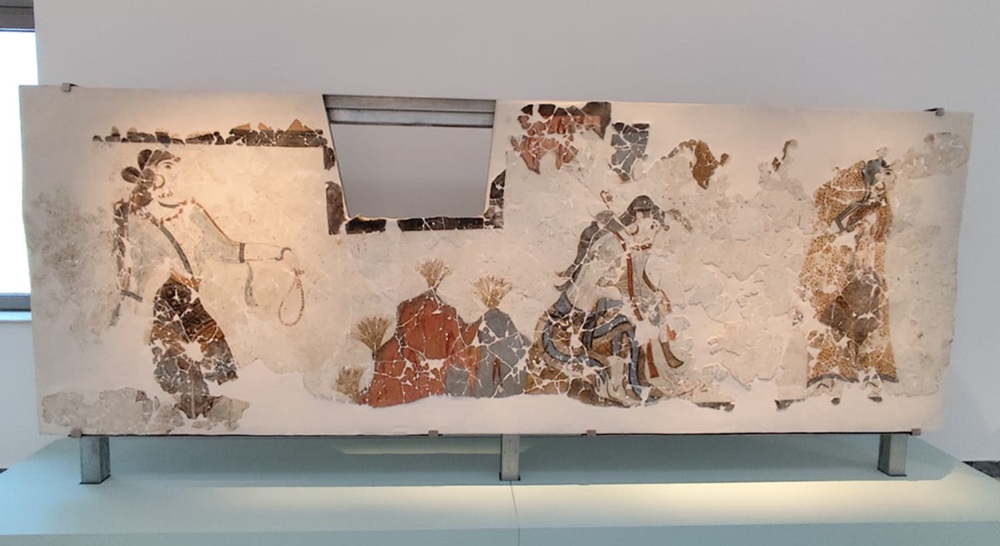
After the successful end of the seismic activity that disturbed Santorini this spring, today we are on the island to accompany the start of the summer tourist season with the reopening of the Archaeological Museum of Thira, which is once again being returned to the local community renovated and upgraded, adding another valuable cultural facility alongside the prehistoric settlement of Akrotiri, the Museum of Prehistoric Thira, and Ancient Thira.
The Museum building, constructed as part of the overall reconstruction of the island following the devastating earthquake of 1956, was designed by the architect Konstantinos Dekavallas, incorporating features of the modern movement such as light wells and visual perspectives towards the settlement and the caldera. The wear of time, new needs in museography and museology, and the increased demands of a growing number of visitors had made extensive renovation and modernization interventions necessary for several years. The works carried out by the Cyclades Ephorate of Antiquities restored the original design of the building, highlighting once again its altered architectural virtues, while simultaneously replacing and upgrading all of its infrastructure and facilities on every level, including energy efficiency and safety.
The central and emblematic exhibit of the renovated Museum is the “Kore of Thera,” an Archaic statue standing 2.48 meters tall, made of Naxian marble, discovered in 2000 in Sellada, the necropolis of Ancient Thera. This important and almost intact find remained unseen and inaccessible to the public for 22 years until autumn 2022, when it was temporarily exhibited in the museum during its renovation phase. Today, the iconic statue of the Kore is displayed in its permanent place, protected by an anti-seismic base designed with all modern specifications by the structural engineering laboratory of the National Technical University of Athens and applied to the sculpture by the Cyclades Ephorate of Antiquities at the Conservation Laboratory of the Acropolis Museum, so that the Kore can stand safely and freely, fully showcasing its archaic beauty.
The Kore of Thera was one of the central exhibits of one of the most important and successful temporary exhibitions of recent years, titled “Kykladitisses: Untold Stories of the Women of the Cyclades,” co-organized by the Ministry of Culture through the Cyclades Ephorate of Antiquities, in collaboration with the Museum of Cycladic Art. Having first been presented with great success at the Museum of Cycladic Art, the “Kykladitisses” exhibition is now hosted at the Archaeological Museum of Thera, renewed and with a new adapted layout, marking the celebratory start of the museum’s new chapter as it is fully returned renovated to the Greek and international public.
This original exhibition presents the history of the Cyclades through a female perspective, highlighting the evolving and transforming role of women in island societies from prehistory to post-Byzantine times. Through personal stories and lesser-known aspects of female experience, it illuminates issues such as identity, equality, participation, and autonomy. It shows how Cycladic women were at times constrained by social stereotypes and at other times played dynamic leading roles in family, religion, economy, and politics. It connects past and present, inviting the audience to reflect on the timeless journey of women as bearers of tradition and agents of change.
The President and CEO of the Museum of Cycladic Art, Sandra Marinopoulou, stated:
“In May 2024, we began a historically significant collaboration with the Ministry of Culture and the Cyclades Ephorate of Antiquities. A collaboration that opens new paths for the research, study, and promotion of Cycladic culture both in Greece and abroad. The collaboration will include a series of joint actions, the most important being the first Corpus, that is, the first digital cataloging of all marble figurines and vessels from the Early Cycladic period held in museums and private collections around the world.
The fruit of this collaboration is the exhibition ‘Kykladitisses.’ A major archaeological exhibition that began its journey in December 2024 at our Museum and has now arrived here. From the very planning of the exhibition, together with the Minister of Culture, Ms. Lina Mendoni, and the Director of the Cyclades Ephorate of Antiquities, Mr. Dimitris Athanasoulis, we judged that the ‘Kykladitisses’ should continue their journey to Santorini to inaugurate the renovated Archaeological Museum of Thira. This decision was another way for us to contribute to the Cyclades, as they are the very reason for the existence of our Museum.”
The Archaeological Museum of Thira, built after the devastating earthquake of 1956 based on designs by architect Konstantinos Dekavallas, has been fully restored with the aim of its functional and aesthetic upgrade. The project included strengthening the building’s structural integrity, improving its energy efficiency, ensuring accessibility for people with disabilities, installing new lighting, and providing modern museographic facilities.
The museum’s central exhibit is the Kore of Thira, one of the most important statues of Greek sculpture, found in Sellada, the necropolis of Ancient Thira. The colossal Archaic Kore of Thira, made of Naxian marble, symbolizes a lesser-known but equally significant period compared to prehistoric Santorini, during which Thira developed dynamically in the 7th–6th centuries BC, centered around the ancient city on Mesa Vouno.
The iconic statue is exhibited for the first time in its permanent place on an anti-seismic base designed with all modern specifications to support the sculpture, protecting it from the high seismic activity of Santorini. Additionally, the new metal base achieves two further key objectives: to avoid causing significant drilling damage to the sculpture and, at the same time, to ensure structural adequacy so that the statue stands free from any modern supporting construction, thereby highlighting the quality and beauty of the Archaic Kore of Thira. The design of the base was commissioned by the Ministry of Culture and prepared by the structural engineering laboratory of the National Technical University of Athens. The implementation of this complex construction was carried out by external collaborators, while the particularly demanding installation on the sculpture was performed by the Cyclades Ephorate of Antiquities at the Conservation Laboratory of the Acropolis Museum.
The Archaeological Museum of Thira opened its doors with the exhibition “Kykladitisses,” the first ever pan-Cycladic, diachronic exhibition organized for the Cyclades. Leading exhibits—Cycladic women from across the Archipelago—surround the Kore of Thira in her permanent home, lending a celebratory character to the Museum’s inauguration. The temporary exhibition was organized by the Ministry of Culture through the Cyclades Ephorate of Antiquities and the Museum of Cycladic Art (MCA), within the framework of a related memorandum of cooperation. The Municipality of Thira also participates as a co-organizer. This is the largest exhibition production ever organized in the Cyclades, offering a unique opportunity to admire exhibits that would otherwise require traveling to all the Cycladic islands to see. At its core are important finds from the archaeological treasures of Santorini. Additionally, for the first time, significant Cycladic figurines from the MCA’s permanent collection—including the important Early Cycladic female statue—are exhibited in their birthplace, the Cyclades.
With the completion of the project, the Archaeological Museum of Thira is dynamically integrated into the cultural map of the Cyclades and the country, constituting a modern, functional, and highly aesthetic archaeological space with an international outlook.
The inauguration ceremony was attended by the Metropolitan of Thira, Amorgos, and the Islands, Mr. Amfilochios; Deputy Minister of Development and Food, Dionysis Stamenitis; Cyclades Members of Parliament Filippos Fortomas, Katerina Monogiou, and Markos Kafouros; General Secretaries of Culture Giorgos Didaskalou and Rural Development Dimitris Papagiannidis; Deputy Regional Governor Giorgos Leontaritis; Mayor of Thira Nikos Zorzos; and a large crowd.

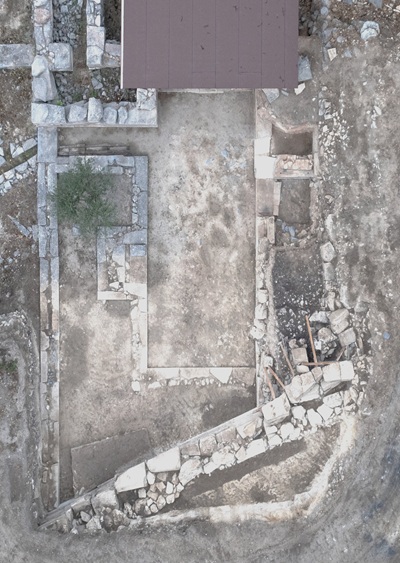
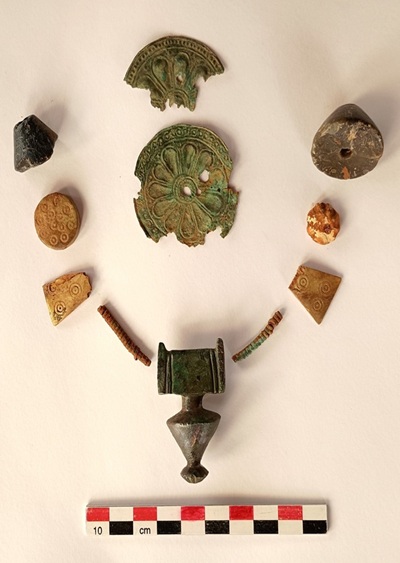
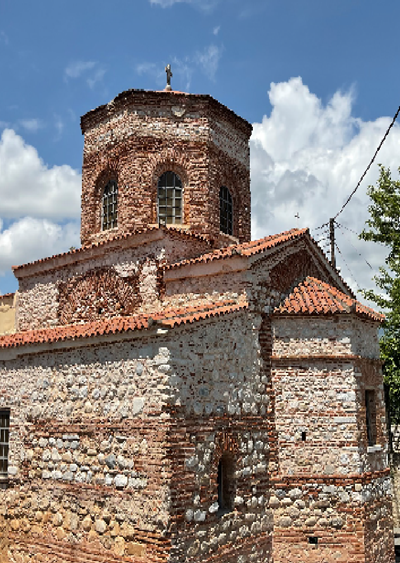
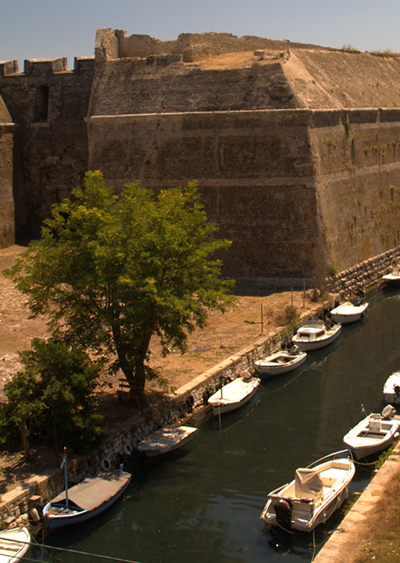


Leave A Comment